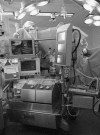Vacuum-assisted venous drainage, angel or demon: PRO?
- PMID: 23930382
- PMCID: PMC4557578
Vacuum-assisted venous drainage, angel or demon: PRO?
Abstract
Vacuum-assisted venous drainage (VAVD) was proposed to optimize venous drainage during bypass through femoral venous cannulation. It is currently used in both adult and pediatric surgery when siphon gravity venous drainage is suboptimal. In pediatric surgery, the major advantages of VAVD are a significant decrease in cardiopulmonary bypass prime volume and an improved drainage with all collateral benefits. To limit gravity drainage, we use a two-level heart-lung machine dedicated to pediatric perfusion. The top level of the cardiotomy reservoir is positioned at the patient atrial level, making it possible to downsize the length and diameter of venous and arterial lines. Since 2008, a negative pressure of approximately -30 mmHg has been used for all patients. Initiation of bypass is performed in a classical way with a cardiotomy reservoir open; vacuum is added as soon as the maximal gravity drainage is reached. During bypass, when the blood level in the reservoir decreases to the safety limit level, a small increase in negative pressure is used to improve venous drainage. For weaning from bypass, the negative pressure is gradually decreased to zero, then the reservoir is opened and the venous line progressively closed. Prime volumes were significantly reduced to 100 mL for small neonates, 125 mL for infants, and 175 mL for older children with flow up to 1.5 L/min(-1). A low prime volume is expected to improve blood conservation and decrease donor exposure, prevent drawbacks of transfusion (immunomodulation, infection), increase the incidence of blood-free surgery in smaller babies, and decrease whole body systemic inflammation by decreasing surface of foreign material in contact with blood and inflammation associated with blood transfusion. The main drawbacks described have been retrograde flow in the venous line with cerebral air embolus and an increased incidence of gaseous microemboli. These drawbacks are avoidable through appropriate training of perfusionists. When negative pressure is "reasonable," complications are more theoretical than significant in clinical practice. A technique with a benefit/drawback ratio of 1:0 is utopian, but the advantages of VAVD far outweigh any potential drawbacks when applied properly.
Conflict of interest statement
The author has stated that he has reported no material, financial, or other relationship with any healthcare-related business or other entity whose products or services are discussed in this paper.
Figures


Similar articles
-
Vacuum assist: angel or demon CON.J Extra Corpor Technol. 2013 Jun;45(2):128-32. J Extra Corpor Technol. 2013. PMID: 23930383 Free PMC article.
-
Vacuum-assisted venous drainage and gaseous microemboli in cardiopulmonary bypass.J Extra Corpor Technol. 2008 Dec;40(4):249-56. J Extra Corpor Technol. 2008. PMID: 19192754 Free PMC article. Review.
-
Vacuum-assisted venous drainage: to air or not to air, that is the question. Has the bubble burst?J Extra Corpor Technol. 2002 Mar;34(1):24-8. J Extra Corpor Technol. 2002. PMID: 11911625
-
Does vacuum-assisted venous drainage increase gaseous microemboli during cardiopulmonary bypass?Ann Thorac Surg. 2002 Dec;74(6):2132-7. doi: 10.1016/s0003-4975(02)04081-x. Ann Thorac Surg. 2002. PMID: 12643407
-
Generation, detection and prevention of gaseous microemboli during cardiopulmonary bypass procedure.Int J Artif Organs. 2011 Nov;34(11):1039-51. doi: 10.5301/ijao.5000010. Int J Artif Organs. 2011. PMID: 22183517 Review.
Cited by
-
American Society of ExtraCorporeal Technology: Development of Standards and Guidelines for Pediatric and Congenital Perfusion Practice (2019).J Extra Corpor Technol. 2020 Dec;52(4):319-326. doi: 10.1182/ject-2000045. J Extra Corpor Technol. 2020. PMID: 33343035 Free PMC article. Review.
References
-
- Jones RE, Donald DE, Swan HJ, Harshbarger HG, Kirklin JW, Wood EH.. Apparatus of the Gibbon type for mechanical bypass of the heart and lungs; preliminary report. Proc Staff Meet Mayo Clin. 1955;30:105–113. - PubMed
-
- Jegger D, Tevaearai HT, Horisberger J, et al. . Augmented venous return for minimally invasive open heart surgery with selective caval cannulation. Eur J Cardiothorac Surg. 1999;16:312–316. - PubMed
-
- Banbury MK, White JA, Blackstone EH, Cosgrove DM 3rd.. Vacuum-assisted venous return reduces blood usage. J Thorac Cardiovasc Surg. 2003;126:680–687. - PubMed
-
- Durandy Y.. The impact of vacuum-assisted venous drainage and miniaturized bypass circuits on blood transfusion in pediatric cardiac surgery. ASAIO J. 2009;55:117–120. - PubMed
MeSH terms
LinkOut - more resources
Full Text Sources
